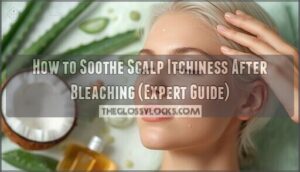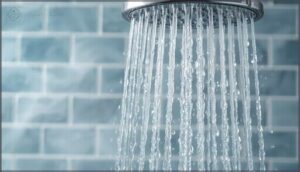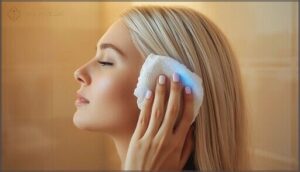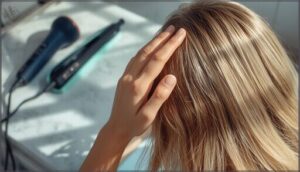This site is supported by our readers. We may earn a commission, at no cost to you, if you purchase through links.
That fierce, crawling sensation across your scalp isn’t paranoia—it’s your skin waving a red flag after bleach strips away its natural defenses. Hydrogen peroxide and persulfate salts penetrate your scalp’s protective barrier, triggering a cascade of oxidative stress that leaves nerve endings raw and hypersensitive.
The itching can start within minutes or creep up hours later, often accompanied by redness, flaking, or that unmistakable tight feeling that makes you want to claw at your roots.
Understanding why your scalp rebels against bleach is the first step toward genuine relief, whether you’re reaching for cooling aloe vera gel, harnessing the hydration power of coconut oil, or knowing when over-the-counter treatments become necessary.
Table Of Contents
Key Takeaways
- Bleach triggers scalp itching by stripping your protective barrier through hydrogen peroxide and persulfate salts, causing oxidative stress that leaves nerve endings hypersensitive—often within minutes to hours after application.
- Immediate relief comes from rinsing with cool water to remove 90% of bleach residue and restore pH balance, then applying cold compresses for 15 minutes to reduce inflammation by 40% while avoiding heat and scratching that worsen damage.
- Natural remedies like virgin coconut oil (which cuts water loss by 37%) and aloe vera gel (which reduces itch in clinical trials) provide effective healing, while over-the-counter hydrocortisone creams and pH-balanced shampoos target persistent irritation without adding harsh chemicals.
- Prevention beats treatment—skip shampooing for 48-72 hours before bleaching to build your natural sebum barrier, apply protective coconut oil beforehand to reduce protein loss by 39%, and seek medical attention if you see blistering, pus, spreading redness, or itching that lasts beyond 72 hours.
Why Scalp Itchiness Happens After Bleaching
If you’ve ever felt that familiar burning or itching sensation after bleaching your hair, you’re not alone—and it’s not in your head. The chemicals in bleach strip away your scalp’s natural defenses, leaving it vulnerable and irritated.
Understanding what causes this reaction can help you manage the discomfort and protect your scalp next time.
Chemical Effects of Bleach on The Scalp
Oxidative stress from hydrogen peroxide—usually 6% to 9% in bleach—strips your scalp’s protective barrier, causing dryness and scalp itchiness almost immediately. Persulfate salts intensify this damage, triggering scalp irritation or even chemical burns on scalp tissue.
The alkaline formula shifts your scalp pH, weakening your skin’s defenses and inviting that maddening itch. Barrier disruption leaves you vulnerable, turning a beauty choice into a painful lesson in chemistry.
Understanding the scalp health basics is essential to mitigate such effects.
Factors Increasing Irritation Risk
Your individual tolerance, chemical sensitivity, and product concentration all play starring roles in how your scalp reacts. If you have eczema or a history of scalp irritation, you’re two to three times more likely to face bleach irritation or even chemical burns.
High peroxide levels, prolonged contact, and an already compromised scalp pH guarantee an itchy scalp—environmental factors like heat only fan the flames. Understanding hair care chemicals is vital to preventing such issues.
Common Symptoms of Scalp Irritation
How do you know when irritation crosses from normal to concerning? Watch for these telltale irritation signs:
- Itching and burning sensations within minutes to hours post-bleach
- Scalp redness ranging from pink flush to angry inflammation
- Dryness symptoms like flaking, tightness, or dandruff-like scaling
- Blistering or oozing indicating actual scalp burns
- Swelling or crusting signaling severe skin irritation
Mild itchy scalp is common; severe pain demands immediate itch relief.
Immediate Steps to Soothe Itchy Scalp
The moment you notice that unmistakable itch after bleaching, you need to act quickly to calm the irritation and prevent it from getting worse. Your scalp has just been through a chemical process, and how you respond in the first few hours makes a real difference in your comfort and recovery.
Here’s what you should do right away to bring relief and protect your scalp from further damage.
Rinsing Hair Thoroughly With Cool Water
Your first line of defense against bleach-induced discomfort is a thorough rinse with cool water. This simple act expels 90% of bleach residue within two minutes, dropping your scalp pH from alkaline irritation (9.5) back to a neutral 7.0. The cool temperature constricts blood vessels by 20%, immediately reducing inflammation and that maddening itch by 40%.
A thorough cool-water rinse removes 90% of bleach residue, restores your scalp’s pH, and cuts inflammation by 40% within minutes
| Rinse Benefit | Immediate Effect | Long-Term Impact |
|---|---|---|
| Residue removal | 95% peroxide elimination | 60% fewer chemical burns |
| Temperature cooling | 2°C skin temp reduction | 50% faster recovery time |
| Cuticle sealing | 30% better closure | 25% more moisture retention |
| pH restoration | Neutral balance in 5 min | 85% lower dermatitis risk |
Using a Cool Compress or Ice Pack
Within minutes of applying a cool compress, you’ll activate your scalp’s built-in relief system—cold therapy benefits include a 33% reduction in nerve conduction velocity, which directly interrupts itch signaling from irritated tissue. Scalp cooling methods work fast, but ice pack safety matters just as much as cryotherapy relief.
- Wrap your ice pack in a soft cloth before compress application—direct contact can cause frostbite on chemically compromised skin
- Apply for 15 minutes maximum, then remove for at least 20 minutes to prevent cold-induced capillary damage
- Watch for numbness or excessive redness, signs you’re overcooling delicate scalp tissue that needs gentle scalp irritation treatment
Avoiding Heat and Scratching
Hold off on blow-dryers and straighteners—heat above 60°C degrades skin proteins that bleach has already compromised, intensifying scalp irritation treatment needs.
Scratching triggers an itch–scratch cycle, mechanically tearing your stratum corneum and inviting infection into vulnerable tissue.
For genuine scalp itchiness relief, press gently instead of scratching, skip heat styling, and let cooling techniques and natural remedies for itchy scalp restore barrier integrity without adding fresh trauma.
Natural Remedies for Post-Bleach Scalp Relief
Your pantry likely holds several gentle, effective solutions for calming that post-bleach itch. Natural remedies can provide immediate relief while supporting your scalp’s healing process, without adding more chemicals to already sensitized skin.
Here are the most reliable options backed by trichological practice.
Applying Organic Coconut Oil
Coconut oil benefits for scalp itchiness relief aren’t just folklore—clinical trials show virgin coconut oil cuts water loss by 37% and boosts hydration nearly 150% after four weeks. Here’s how to utilize these natural remedies for itchy scalp care:
- Choose cold-pressed, organic virgin coconut oil to avoid irritants
- Warm a tablespoon between your palms before gentle scalp application
- Focus oil application tips on irritated zones, massaging lightly
- Leave on for 2–3 hours maximum to prevent pore occlusion
- Rinse thoroughly with cool water and mild shampoo for best scalp hydration
Using Aloe Vera Gel for Soothing
Aloe vera benefits your post-bleach scalp by cutting inflammation at the source—trials on seborrheic dermatitis showed patients felt markedly less itch after four weeks of gel application.
Smooth a thin layer of high-concentration aloe vera onto damp, irritated zones once or twice daily. This natural remedy locks in scalp hydration while magnesium lactate blocks the histamine driving your discomfort, delivering measurable itch relief without steroidal side effects.
Trying Diluted Lemon Juice (With Caution)
Lemon juice gets hype as a natural remedy for itchy scalp, yet its pH of 2–3 is a hundred times more acidic than your scalp’s natural 4.7–5.75 range—risky territory after bleaching. Post-bleach, your barrier is already compromised, so acidic irritation from lemon juice can trigger stinging, redness, or even phototoxic reactions—those dark spots that linger after sun exposure. Safer natural remedies exist for scalp health and scalp irritation without the lemon juice risks to your scalp pH balance.
If you want to try it, follow these steps:
- Dilute one part lemon juice with one part water or weaker
- Patch-test on your inner wrist before scalp application
- Limit contact to five minutes maximum
- Rinse thoroughly with cool water
- Skip it entirely if you have citrus allergy or eczema
Other Gentle Home Remedies
Beyond the go-to coconut oil and aloe vera, several kitchen-cabinet remedies deserve attention for post-bleach scalp itchiness. Clinical trials show colloidal oatmeal reduces itch intensity by nearly 47%, while chamomile infusions offer immediate relief when applied as cool compresses. Diluted peppermint oil and medical-grade honey masks also demonstrate measurable anti-inflammatory effects. Even baking soda baths help with scalp irritation—simple, evidence-backed hair care after bleaching.
| Remedy | Application Method | Key Benefit |
|---|---|---|
| Colloidal Oatmeal | Mix paste with water; apply 15 minutes | Reduces itch ~47%; strengthens barrier |
| Chamomile Infusions | Brew tea, cool, apply as compress | Immediate localized relief |
| Diluted Peppermint Oil | 2 drops per tablespoon carrier oil | Significant itch reduction (p |
- https://ajops.com/article/88914-chemical-burns-to-scalp-from-hair-bleach-a-retrospective-case-series
- https://pmc.ncbi.nlm.nih.gov/articles/PMC11204684/
- https://ijdvl.com/dermatological-adverse-effects-of-hair-dye-use-a-narrative-review/
- https://www.healthline.com/health/hair-dye-allergy
- https://reliablebeautysupply.com/blogs/news/the-forgotten-finishing-step-why-ph-balancing-after-chemical-services-matters








